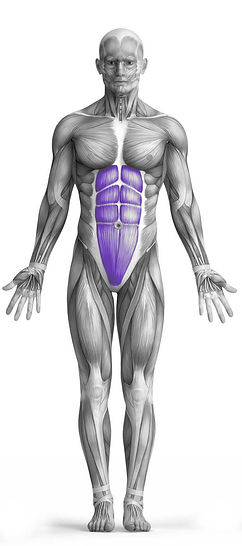Tip-Toe Crunch 101 Video Tutorial
0

Exercise Synopsis
Target Muscle Group
Abs
Secondary Targets
Execution
Isolation
Force Type
Core
Required Equipment
Bodyweight
Fitness Level
Intermediate
Variations
None
Alternatives
None
Timer
Hour
Minute
Second
Stopwatch
00:00:00:00
Overview
The Tip-Toe Crunch is an effective bodyweight exercise designed to target the abdominal muscles while also engaging the hip flexors. By lying on your back and lifting your legs while keeping your feet in a tip-toe position, you perform a crunch that primarily works the abs. The elevated leg position increases the activation of the lower abs and adds an element of challenge to the standard crunch. This exercise helps improve core strength and stability without the need for additional equipment, making it a convenient choice for a core-focused workout.
How to Perform
Starting Position:
Lie flat on your back on a comfortable surface, such as a mat or carpet.
Extend your legs straight out and keep your arms at your sides with your palms facing down.
Lift your legs off the ground slightly, keeping them straight, and point your toes toward the ceiling.
Engage Core:
Tighten your abdominal muscles and press your lower back into the floor to stabilize your spine.
Ensure your lower back remains in contact with the floor throughout the exercise.
Perform the Crunch:
Slowly lift your upper body off the ground by contracting your abdominal muscles.
As you lift, aim to bring your shoulder blades off the floor and reach your hands towards your feet.
Keep your legs elevated in the tip-toe position throughout the movement.
Hold and Squeeze:
At the top of the crunch, hold the position for a brief moment and squeeze your abs to maximize contraction.
Ensure your neck is in a neutral position and avoid straining it.
Lower Down:
Gradually lower your upper body back down to the starting position, maintaining control and keeping your core engaged.
Keep your legs elevated and in the tip-toe position as you return to the ground.
Repeat:
Perform the desired number of repetitions, usually 12-15, maintaining a steady and controlled pace.
Focus on using your abs to lift your torso and avoid pulling with your neck or shoulders.
Cool Down:
After completing your set, gently stretch your abdominal muscles and hip flexors to promote flexibility and reduce muscle tightness.
Tips
Keep your legs elevated and straight throughout the exercise.
Engage your core and press your lower back into the floor.
Lift your upper body by contracting your abdominal muscles.
Ensure your neck remains neutral and avoid straining it.
Reach your hands towards your feet during the crunch.
Hold the top position briefly and squeeze your abs for maximum contraction.
Lower your upper body back to the ground slowly and with control.
Maintain the tip-toe position of your feet throughout the movement.
Perform each repetition with a steady, controlled pace.
Focus on using your abs rather than pulling with your neck or shoulders.
How Not to Perform
Do Not Strain Your Neck:
Avoid pulling on your neck or tucking your chin excessively during the crunch. This can cause neck strain. Keep your neck in a neutral position.
Do Not Use Momentum:
Avoid swinging your upper body or using momentum to lift yourself. Focus on controlled movements using your abs to lift your torso.
Do Not Allow Your Lower Back to Lift:
Ensure your lower back remains pressed into the floor. Arching your lower back can strain your spine and reduce the effectiveness of the exercise.
Do Not Let Your Legs Drop:
Keep your legs elevated and straight throughout the exercise. Letting your legs drop can shift focus away from your abs and reduce engagement of the hip flexors.
Do Not Rush the Movement:
Perform the exercise slowly and with control. Rushing through the movement can lead to poor form and ineffective targeting of the abs.
Do Not Overextend Your Crunch:
Avoid lifting your upper body too high. A small, controlled crunch is more effective for targeting the abs and preventing lower back strain.
Do Not Hold Your Breath:
Breathe steadily throughout the exercise. Holding your breath can increase internal pressure and reduce core engagement.
Do Not Use Your Hands for Assistance:
Keep your hands by your sides and avoid using them to push or pull yourself up. This ensures that your abs are doing the work.
Do Not Neglect Form for Quantity:
Focus on maintaining proper form rather than performing a high number of repetitions. Quality of movement is more important for effectiveness and safety.
Do Not Ignore Discomfort:
If you experience sharp pain or discomfort, stop the exercise immediately. Discomfort could be a sign of improper form or an underlying issue.
Variations
Variations of fitness exercises refer to different ways of performing a specific exercise or movement to target various muscle groups, intensities, or goals. These variations aim to challenge the body differently, prevent plateaus, and cater to individuals with varying fitness levels.
Alternatives
Alternative exercises in fitness refer to different movements or activities that target similar muscle groups or serve the same training purpose as the primary exercise. These alternative exercises can be used as substitutes when the original exercise is unavailable or challenging to perform due to various reasons such as equipment limitations, injuries, or personal preferences.



